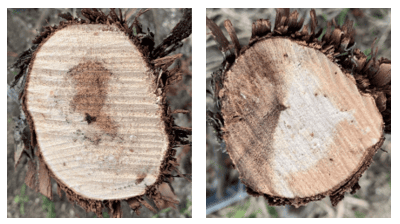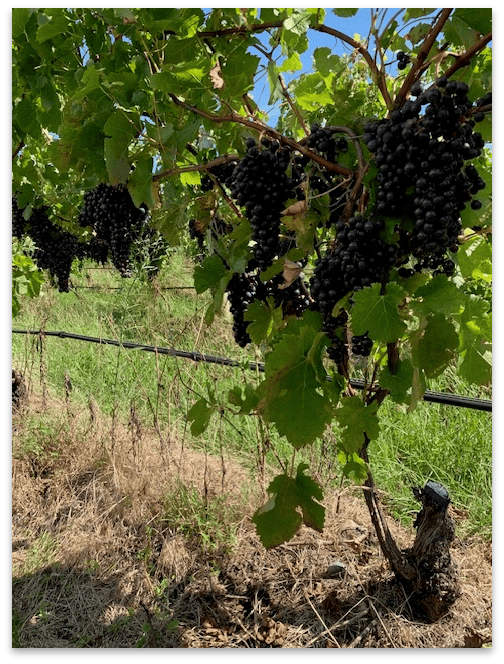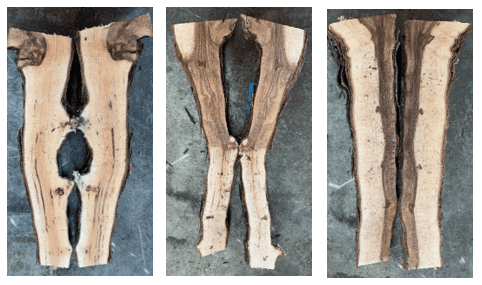Eline van Zijll de Jong, Linnaeus Limited, and Mark Sosnowski, South Australian Research and Development Institute
What is grapevine trunk disease?
When gaps begin to appear in the canopies of mature vines, or when vine mortality increases, it is often indicative of grapevine trunk disease (GTD). This disease is caused by various fungi that primarily enter the vines as spores through pruning wounds (Figure 1). Over time, these fungi colonise the wood and progressively move down into the vine’s trunk. This results in the decay and death of the wood, disrupting the flow of water and nutrients until the vine eventually perishes.

Figure 1. Symptoms of dieback in the canopy of a cane-pruned vine (left) and spur-pruned vine (right)
Based on the symptoms observed in the canopy and the associated fungi, these top-down trunk diseases are commonly known as Botryosphaeria dieback (BD) and Eutypa dieback (ED). Typically, the trunks exhibit red-brown staining around the central pith or brown wedges extending from the pith to the outer edge (Figure 2). Affected areas may develop cankers, leading to the loss of bark and wood splitting. Spores released from fruiting bodies on infected wood are dispersed by rain splash or wind, leading to new infections of pruning wounds. The disease leads to significant yield and quality reductions and combined with a shortened lifespan is threatening the economic sustainability of New Zealand’s aging vineyards.
Figure 2. Trunk cross-sections with central (left) and wedge (right) brown-stained wood associated with grapevine trunk disease
What can growers do about GTD?
The most effective strategy against trunk disease is prevention. Applying wound protection has proven effective in preventing infections from both BD and ED pathogens. Additionally, it is advisable to avoid pruning immediately after rain events, as this is when spores are more likely to be present.
Many older vineyard blocks have not received wound protection from the time they were established. As trunk disease progresses only slowly, the impacts of past infections are only now becoming apparent. In the absence of curative treatments, remedial surgery is one of the few effective options for improving and prolonging the productive life of infected vines.
What is remedial surgery?
Remedial surgery involves removing the diseased portion of the trunk above the graft union and replacing it with a new shoot (Figure 3). This technique preserves the established root system, allowing the vine to recover more rapidly than if it were replanted. While remedial surgery has been successfully implemented to manage trunk disease in own-rooted vines in commercial vineyards across Australia, it has not been widely applied to grafted vines.
Figure 3. A grapevine after remedial surgery
Research on remedial surgery in grafted vines
In 2019, three research trials were established in mature vineyard blocks as part of the Vineyard Ecosystems Programme to explore effective practices for managing GTD through remedial surgery. The trials were conducted in an organically managed block of Sauvignon Blanc and two conventionally managed blocks of Cabernet Sauvignon and Merlot in Hawke’s Bay. Each year in each trial, four rows were reworked over a five-year period in winter and then a further four rows in spring. The health and productivity of the vines were closely monitored before and after remedial surgery and compared to the untreated control vines. These trials, the most comprehensive in the world, are addressing key grower questions on the optimal timing for intervention, location of cuts, watershoot recovery, disease control, and the impact on yield and wine quality.
When to intervene?
By the time growers consider remedial surgery for trunk disease, it is often already widespread. In two of the trials (Sauvignon Blanc and Cabernet Sauvignon) dieback was observed in over 80% of vines. In the third trial (Merlot) the incidence was recorded at 60%. By the fifth year, nearly all vines exhibited canopy symptoms, and the severity of these symptoms had increased over time.
Staining was frequently observed in the trunks at the remedial cut site (150-200 mm above the graft union) in two of the trials (Sauvignon Blanc and Merlot), affecting 40-50% of the vines initially and rising to close to 80% by the fifth year (Figure 4). Over this period, the severity of the staining also increased.

Figure 4. Changes in the incidence (solid line) and severity (dashed line) of brown wood staining in cross-sections at the remedial cut site in Sauvignon Blanc (A), Sauvignon Cabernet (B) and Merlot (C) grapevines reworked annually from 2019 to 2023. The error bar indicates the least significant difference (LSD 5%).
The extent of trunk staining could not be predicted based on dieback symptoms observed in the canopy (Figure 5). This is primarily because infections can develop over multiple years, not only from sites in the upper trunk but also from wounds caused by watershoot and spur removal from the lower trunk.
Regular monitoring of both the canopy and, eventually, the trunk is essential for effectively removing diseased wood and promoting the growth of watershoots.
Figure 5. Distance of wood staining observed in the trunks of spur-pruned vines with 25% canopy dieback
How to monitor for GTD?
Monitoring for trunk disease begins with assessing the canopy in mid to late spring before it is fully developed and gaps are still visible (Figure 1). In spur-pruned vines, the severity of dieback can be estimated by evaluating the percentage of unproductive cordon. For cane-pruned vines, tracking the disease is more challenging due to the regular replacement of spurs and canes. In these cases, assess the percentage of dead and unproductive sections on the heads and canes. The number of rows to be inspected will depend on variety, the incidence and severity of the disease, as well as the acceptable margin of error, and ranges between 1-6 rows of 100 vines.
As an increasing number of vines show symptoms of the disease, the trunks should be examined to establish the distance and severity of staining in the vines. The tendency of vines to produce new watershoots should also be noted.
When to cut the vine?
Remedial surgery should be conducted before the disease becomes widespread and severe, as the health of both the canopy and trunk significantly impacts watershoot recovery. As the disease advances, the growth of watershoots typically declines. In Merlot, where the disease was less severe, recovery rates were 100%. In contrast, recovery rates for Sauvignon Blanc and Cabernet Sauvignon decreased when dieback severity surpassed 70% and 40%, respectively. Over five years, as the disease progressed, recovery rates dropped from 97% to 85% in Sauvignon Blanc and from 87% to 79% in Cabernet Sauvignon.
The old trunks can be replaced in either winter or spring. There was no improvement in watershoot recovery when the vines were remediated in spring compared to winter. Vines cut in winter generally experienced earlier bud burst, having longer shoots by late spring, compared to those cut in spring. In vineyard blocks prone to late frosts, the risk of frost damage to buds is lower for vines cut in spring. Also of note, vines remediated in spring tended to have more sap flow at the cut site, making application of wound sealant challenging. In this case, it is advised to wait until sap stops flowing, scrape off the exudate, and then apply the sealant.
Where to cut the vine?
The trunks of diseased vines should be cut as close to the graft union as possible while ensuring enough bud sites are left for new growth and adequate space is provided between these sites and the top of the trunk to accommodate natural dieback. Ideally, the remedial cut site is well below any visible staining, as pathogens can spread beyond the stained areas. BD pathogens were regularly detected >200 mm ahead of the staining. The ED pathogen, which was often detected together with the BD pathogens, was also occasionally detected over this distance. In addition, the staining observed from extending from watershoot removal wound sites and mechanical damage was often low down the trunk.
Research is ongoing to understand the implications of failing to completely remove the diseased wood and associated pathogens. BD pathogens were frequently found at the base of new trunks, even when staining in the original trunk was located some distance from the remedial cut site. It may be easier to eliminate the ED pathogen, which typically does not advance as far beyond the staining as BD pathogens and is rarely detected at the base of new trunks.
Impact on vine health and longevity
Although it is still early in the trials, the majority of vines that produced watershoots were still thriving by the fifth year (Figure 3). While some vine deaths were recorded, there were no noticeable signs of trunk disease in the new trunks and shoots. Similar to young vines, the disease may take some years before becoming apparent. In contrast, the untreated control vines showed a continuous increase in the incidence and severity of the disease.
Monitoring disease recurrence, death and yields of vines in these trials in the future will provide valuable data that could help predict the extended productive life of vineyards based on the disease symptoms at the time of remedial surgery.
The high vigour of the reworked vines, due to the retention of the original root system, was effectively managed by keeping two shoots. The second trunk can be removed after several years once vines are established.
Impact on vine productivity
There was a rapid decline in productivity in the untreated control vines, especially in spur-pruned vines, even during high-yielding vintages (Figure 6). While no fruit was harvested from the reworked vines during the first growing season after remedial surgery, by the second growing season, their yields matched or exceeded those of the control vines. In high-yielding vintages, the yields from reworked vines approached or exceeded the target yields for the blocks. Future monitoring of these trials will provide a better understanding of the long-term impact on productivity of remedial surgery.

Figure 6. Mean yield of fruit from the control and in Sauvignon Blanc (A), Sauvignon Cabernet (B) and Merlot (C) grapevines reworked annually from 2019 to 2022. The error bar indicates the least significant difference (LSD 5%)
In a related project, wine was made in the Bragato Research Institute (BRI) winery using fruit harvested from vines in the Sauvignon Blanc trial. Remediation of vines affected by trunk disease resulted in wines with increased levels of 2-methoxy-3-iso-butylpyrazine (IBMP), compared with untreated control vines. IBMP is a key aroma compound responsible for the distinctive green and grassy aromas characteristic of high-quality Marlborough Sauvignon Blanc wines.
What’s next?
In an extension of the project funded by BRI, the health and productivity of the reworked vines will be monitored over the next two years to assess both the impact of remedial surgery and the costs associated with delaying intervention. The data collected from these trials will form the foundation for an economic analysis aimed at quantifying the cost-benefit of remedial surgery and providing growers with valuable decision-support tools. This is becoming more important with the increasing number of New Zealand vineyards beyond the age of 20 years, when production is seriously impacted by GTDs, and decisions on reworking or replanting need to be made.
About the project
This five-year research project was funded through the Vineyard Ecosystems Programme, a multi-year partnership between New Zealand Winegrowers and the Ministry for Business, Innovation and Employment that was managed through Bragato Research Institute. Read more here.



















